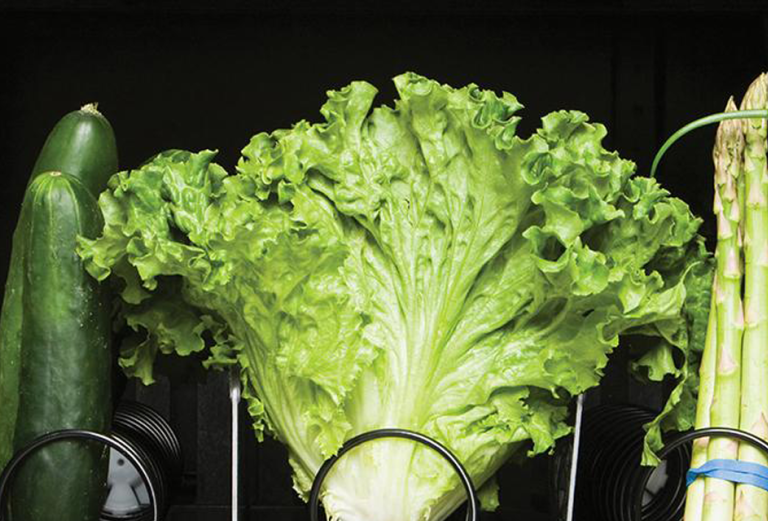
Kate feels like she’s tried everything: Weight Watchers, Jenny Craig, grueling workouts at the gym. Yet she could swear those extra 50 pounds remain, stubbornly stuck to her hips. When she confesses her exasperation during her annual physical, her physician makes an intriguing suggestion: Allow him to take a blood sample. Although she’s pretty sure that obesity is obvious without a test, she goes along with her doctor’s request.
The results are stunning. Kate’s blood reveals a genetic sensitivity to carbohydrates, explaining in part why she doesn’t respond well to low-fat diets, which tend to be abundant in such refined carbs as pasta and rice. With this knowledge, her physician tailors a diet to work with her individual biochemistry, greatly increasing the odds that she’ll shed those pounds—and keep them off.

Although this sounds like yet another weight-loss gimmick—or a scene out of Woody Allen’s Sleeper—it is a scenario grounded in hard science. A growing body of nutrition research suggests that a personalized diet based on a patient’s genetic makeup will someday become reality, making the prescription for good nutrition and weight loss as close as a visit to the doctor’s office.
“There’s a lot of excitement in research circles about the concept of dietary phenotypes, or the way our genes interact with food,” says David Ludwig, an HMS professor of pediatrics and director of the New Balance Foundation Obesity Prevention Center at Children’s Hospital Boston. In a study published in 2007 in the Journal of the American Medical Association and reported heavily in the media, Ludwig and his colleagues tested insulin response in a group of 73 obese young adults before giving them either a high-carb, low-fat meal or a low-glycemic meal rich in non-starchy vegetables and legumes. Glycemic measures, often expressed along an index as low, medium, and high, refer to how quickly foods break down and release glucose during digestion. The researchers found that people who tended to secrete high levels of insulin after ingesting glucose, compared with levels secreted by their peers, were more likely to lose weight when they followed a low-glycemic diet than when they adhered to a low-fat diet, probably because they were more sensitive to refined carbohydrates.
These results, says Ludwig, could explain individual differences in the ability to lose weight. “When it comes to food,” he adds, “one size doesn’t necessarily fit all.” Eventually, this knowledge could help physicians learn which patients will respond best to which types of diets—all determined by a simple blood test measuring insulin secretion.
Food for Thought

Patients like our fictional Kate aren’t alone in their struggles with the scale. Recent findings by researchers at the Harvard School of Public Health and elsewhere suggest that billions of people are fighting—and losing—the battle of the bulge. Worldwide, an estimated 1 in 3 adults is overweight and 1 in 9 is obese, according to a study published in February 2011 in The Lancet. The number of obese people now tops half a billion—a doubling of prevalence in less than three decades. And extra pounds don’t just present a threat to our self-esteem. The World Health Organization estimates that obesity-related illnesses, including cardiovascular disease and stroke, type 2 diabetes, and cancers of the breast, endometrium, gallbladder, kidney, colon, and esophagus, claim some 3 million lives each year. Statistics like these are helping to spur investigations into the potential causes of obesity and related diseases—starting with what we put on our plates.
“Research in the 1950s and ’60s first suggested a connection between food and the development of chronic conditions such as heart disease,” says Walter Willett, an HMS professor of medicine and chair of the Harvard School of Public Health’s Department of Nutrition. “Today, we’re continuing to discover that many illnesses may be linked to modifiable risk factors like diet.”
The key to establishing clear and accurate dietary advice may lie in the type of studies investigators conduct. Willett has been a driving force behind some of the largest epidemiological studies on nutrition, including the Nurses’ Health Study, the Nurses’ Health Study II, and the Health Professionals Follow-up Study. These three studies have identified strong relationships between nutrition and disease, including links between the consumption of red meat and an increased risk of colorectal cancer; consumption of alcohol and an increased risk of breast cancer; and consumption of partially hydrogenated fats (also known as trans fats) and an increased risk of cardiovascular disease—data that have helped form much of our current dietary advice and guidelines.
Systematic reviews, in which investigators analyze studies to tease out and compare the similarities and differences in their results, and meta-analyses can provide even more insight into food and disease risk. “One study is never enough to make or break a key finding,” says Eric Ding, an HMS instructor in medicine at Brigham and Women’s Hospital. Ding also is affiliated with the Department of Nutrition at the Harvard School of Public Health. “Research has to be replicated time and again to show a solid relationship between nutrition and health.”
“Different studies may look at the effects of nutrition in varied populations with a range of backgrounds and risk factors,” explains Ding. “Systematic reviews can help account for variations in findings among studies.” Such reviews can also aid investigators in pinpointing specific relationships between food and disease so that umbrella statements about benefit and risk gain precision.
Lean Cuisine
Nutrition research can also overturn misconceptions about diet and health. “There are a lot of strong beliefs in the area of nutrition—it’s not unlike religion,” says Willett. “The trouble is that the strength of these beliefs often seems to be inversely related to the strength of the data.” He points to long-held convictions that eggs are major culprits in cardiovascular disease and that margarine is a healthy alternative to butter. We now know that egg consumption has no real association with heart attacks and that the trans fats found in processed foods, and earlier formulations of margarine, are far worse for cardiovascular health than the saturated fat in butter. Yet this sea change in dietary guidance came only after several decades of research by Willett and scientists at other institutions.
Today, as studies continue to shed light on the most promising foods for good health, one significant theme has emerged: While caloric intake still governs weight gain and loss, what we eat may matter just as much as how much we eat. Ludwig and his colleagues share some responsibility for this shift in thinking. In 1999, curious to better determine how dietary composition affected body-weight regulation, Ludwig’s research team gave 12 obese teenage boys a meal that ranked low, medium, or high on the glycemic index. Each of the meals had the same number of calories, only the foods varied. The meal that registered high on the glycemic-index scale consisted of instant oatmeal, a refined carbohydrate; the medium-indexed meal featured steel-cut oatmeal, a more complex carbohydrate, and the meal low on the glycemic-index scale included an omelet, rich in protein and fat.

The result: blood sugar spiked after instant oatmeal, only to crash a few hours later, leaving the boys much hungrier—and leading them to consume about 700 more calories—than their peers who dined on steel-cut oatmeal or an omelet. “The findings suggested that meals with a high glycemic index provoke hormonal and metabolic changes that trigger overeating,” says Ludwig. “We’ve spent the past 12 years or so refining our research of this concept.”
Studies by Eleftheria Maratos-Flier, an HMS professor of medicine at Beth Israel Deaconess Medical Center, suggest that diet composition has an impact on weight gain and weight loss. Diets high in carbohydrates and fats can pack on the pounds, while those low in sugar and in total carbohydrate may help spur weight loss. In a study published in the June 2007 issue of the American Journal of Physiology, Endocrinology, and Metabolism, Maratos-Flier and colleagues fed mice one of four diets: high-sugar, high-fat; restricted calorie; very-low-carbohydrate, high-fat; or regular chow. While the mice on the high-sugar, high-fat diet became obese, those on the very-low-carbohydrate, high-fat diet lost as much weight as those whose calories were restricted—even though they consumed as many calories as the mice fed the high-sugar, high-fat diet.

Looking more closely, her team identified biochemical processes behind such findings. They found that the very-low-carbohydrate, high-fat diet appeared to stimulate the production of fibroblast growth factor 21, a liver-derived protein that triggers the body to burn fat. Although the effect of low-carbohydrate diets on FGF21 in humans is less clear, Maratos-Flier remains optimistic—and believes such an eating plan may be the key to weight loss for some people. “A successful diet is a successful diet,” she says. “If someone is having trouble losing weight, it’s worth a shot to restrict carbohydrates.”
Fare Trade
Before you switch your cereal for steak, though, consider this: “The quality of macronutrients that we eat is tremendously important for good health,” says Willett. Take fat, for instance. On the whole, it isn’t always bad—the monounsaturated fat in such foods as olive oil and nuts, the polyunsaturated fats in vegetable oils, and the omega-3 fats found in fish like salmon and sardines have all been shown to have cardiovascular benefits.

Likewise, all carbohydrates are not created equal. “Some carbs may be just as problematic for cardiovascular health as saturated fat,” says Ding. Those that rank high on the glycemic index can cause blood sugar levels, and then insulin production, to skyrocket, which can lead to decreases in HDL (“good”) cholesterol and higher levels of triglycerides—both of which can raise cardiovascular risk. Carbohydrates near the top of the glycemic index have also been linked to a greater risk of type 2 diabetes. Over time, the spikes in insulin production that these foods trigger can fatigue the pancreas, so that it stops producing sufficient quantities of the hormone. The inevitable crash in blood sugar levels that follows consumption of these carbohydrates can result in weight gain, too, as the drop tends to spark a feeling of hunger, increasing the likelihood of overeating and, perhaps, increasing the odds of developing heart disease and diabetes.
Although it may seem clear that we should all try to avoid white bread, candy bars, and other carbohydrate culprits that top the glycemic index, troublesome carbohydrates can lurk in less-expected places. Potatoes, especially their baked and mashed forms, Ding notes, rate quite high on the glycemic index—they’ve been shown to raise blood sugar levels as quickly as pure table sugar does—yet their inclusion in the produce food group can cause people to think of French fries as a vegetable rather than a starch.
High amounts of sugar and high-glycemic index carbohydrates work in more insidious ways. “Over the past several years,” says Willett, “we’ve come to see that sugar-sweetened beverages are a very troubling part of the food supply.” Observational studies have linked soft drinks and other sugary beverages to excess weight gain, an association that Willett attributes partly to the drinks’ carbohydrate content but also to their form: It’s easier, he says, to consume more calories when they’re delivered in a liquid. Ding agrees. “If you eat a handful of jellybeans, you know you’re having a snack that’s high in sugar and calories,” he explains. “But you could drink several sweetened beverages and not realize just how much you’re taking in—plus, they’re not filling, so you may find yourself snacking in addition to drinking.”
Although more randomized, controlled trials are needed to firmly establish this relationship, some research suggests that cutting back on sugary drinks may encourage weight loss. Ludwig’s pilot study of 103 adolescents, published in 2006 in Pediatrics, found that reducing intake of sugary drinks among adolescents who were overweight—that is, having a body-mass index (BMI) greater than 25 kg/m2—led to a 0.75 kg/m2 decrease in BMI over a 25-week period, when compared with a control group. For a 160-pound, 5’6” adolescent, this roughly translates to an 11-pound weight loss over the study period.
Vegging Out
If there’s one area of nutrition research where findings seem clear cut, it’s fruits and vegetables. Mom always told us to eat our broccoli, and her advice has been backed up by the U.S. Department of Agriculture’s recommendations to fill our plates with five to nine daily servings of produce. Whether you meet this requirement or not, you likely have heard that fruits and vegetables have powerful anticancer properties.
There’s just one problem. “The benefits of produce for cancer prevention have been greatly overstated,” says Willett. Although early case–control studies suggested that fruits and vegetables might protect against cancer, those studies relied on research participants’ recollection of their diet, a methodology notorious for recall bias. More recently, large prospective studies have examined the role of produce in overall cancer risk, with disappointing results. (To highlight the complexity of such research, Willett points out that these same studies have shown produce’s benefits for cardiovascular disease.) Summing up these findings in a report in the April 21, 2010, issue of the Journal of the National Cancer Institute, Willett wrote that evidence to date suggests that “a broad effort to increase consumption of fruits and vegetables will not have a major effect on cancer incidence.”
So should you toss that salad? Not so fast, say researchers. First, cancer itself can pose a challenge to investigators. “There are so many different types and sub-types,” explains Ding. Some research has identified specific compounds within foods that may indeed help reduce the risk of certain cancers. “Additionally, most cancers have their roots in young adulthood or even earlier, yet the majority of studies have focused on middle-aged and older people,” he adds. “We need to start tracking cancer throughout life to get a clearer picture of risk.”
Even if produce doesn’t protect against cancer, it does appear to promote cardiovascular health: Consumption of at least five daily servings of fruits and vegetables is associated with a 30-percent lower risk of coronary heart disease and stroke. Research also hints at a relationship between fruits and vegetables and a reduced risk of diabetes. And produce can displace less-healthy fare in your diet. When you fill your plate with a rainbow of fruits and vegetables, for example, there’s less room for red meat—consumption of which has been linked to cardiovascular disease.
Life Support
At its most basic, food keeps us alive. And while your main concern about nutrition may be what to make for dinner tonight, nourishment takes center stage for someone who is critically ill or injured. Until about 50 years ago, patients with severe intestinal damage that prevented normal digestion found themselves in a fear-filled race against time: Would their organs heal before they starved to death?
Fortunately, parenteral nutrition has made that fear a thing of the past. In this feeding technique, a catheter delivers a liquid blend of glucose, amino acids, and lipids directly into a patient’s bloodstream, completely bypassing the gastrointestinal system. It is “one of the great medical inventions of the past century,” says Bruce Bistrian, chief of clinical nutrition at Beth Israel Deaconess Medical Center and an HMS professor of medicine. “It allows us to nourish sick people as long as necessary.”
Parenteral nutrition is not without controversy: its use can increase the risk of infection. This drawback has led some physicians to prescribe enteral nutrition, which introduces nutrients directly into the stomach through a tube, for critically ill patients whose intestines still function. Yet a meta-analysis published in Intensive Care Medicine in 2005 found that the mode of feeding patients in intensive care units—whether enterally or parenterally—may matter less in terms of mortality and morbidity than in the timing and amount of nourishment. Providing critically ill patients too much glucose, for instance, can be problematic. “We’re discovering,” says Bistrian, “that starting enteral and parenteral nutrition as soon as necessary and limiting caloric intake to 50 to 70 percent of the daily recommendation decreases the patient’s chances of becoming hyperglycemic, which in turn may lower the risk of infections.”
Some research suggests that this caloric calibration approach may even reduce the inflammatory response of the underlying illness or injury—a dampening action that could potentially speed healing.
Now a regular tool for physicians, parenteral nutrition continues to be fine-tuned. “It’s a well-established therapy,” says Bistrian. “But we still have much to learn.”
Details, Details

It may turn out that the real benefits of such foods as fruits, vegetables, and whole grains are found in the individual compounds they contain.
“We should be looking not just at macronutrients like fat, carbohydrates, and protein, but at micronutrients as well,” says C. Ronald Kahn, the Mary K. Iacocca Professor of Medicine at HMS and head of the Integrative Physiology and Metabolism section at Joslin Diabetes Center. To that end, he investigated the effects of leucine, an amino acid found in dietary protein that appears to play a role in insulin signaling. For the study, published in 2011 in PloSOne, he and his team gave rats twice the normal amount of leucine in their chow, then fed them either a regular or a high-fat diet. They found that the rats receiving extra leucine showed reductions in blood sugar levels and less fat in their livers. High blood sugar and fat harbored in the liver can contribute to what is known as metabolic syndrome, an array of medical disorders that, taken together, can increase a person’s risk for cardiovascular disease and diabetes. The rats were also better able to respond to insulin production and to handle glucose, even though leucine didn’t help them lose weight. “Adding just this one amino acid to the diet changed the metabolism in a lot of different pathways,” says Kahn. “It’s evidence that even a small dietary change can make a big difference.”
Folate, a B vitamin found in such foods as leafy greens, legumes, sunflower seeds, and orange juice, also shows promise for good health—but only in some people. Once touted for its potential to reduce the risk of heart disease, folate has had disappointing effects in many studies. “This is another case where we need to look at the specific populations being studied,” says Ding. He points out that studies of U.S. men and women show little cardiovascular benefit from this vitamin, but adds that very few Americans are deficient in folate. “But meta-analyses,” Ding notes, “actually suggest that folate may indeed help prevent stroke in people who have low blood levels of it.”
A similar careful approach to nutrition research may someday shed light on the health effects of vitamin D, says Ding. Found in seafood, dairy products, and fortified cereals, this vitamin is being heavily studied for its role in diseases as diverse as osteoporosis, multiple sclerosis, diabetes, and prostate, breast, and colorectal cancers. Yet researchers still need to tease out many of the particulars, including refining what blood levels of the vitamin are optimal and whether the vitamin prevents the onset or worsening of these diseases.
Food Fight
For many nutrition researchers, the work doesn’t end in the lab. Instead, they are using their findings to help educate consumers; overhaul the food available in schools, hospitals, and workplaces; and in some cases, even change public policy. Willett and colleagues have created research-based versions of the USDA’s food pyramid and healthy plate icons, aimed at helping people make healthier meal choices without the influence of lobbyists, an influence that sparked criticism of the government’s guidelines. He hopes that hospitals and schools will begin applying these dietary recommendations to their cafeterias. Although Willett was instrumental in improving the culinary choices offered at the Harvard School of Public Health, he finds that the fare at some Boston-area hospitals remains dismal and that many academic institutions are still failing nutritionally. “These places,” he says, “are literally feeding the obesity epidemic.”
Ludwig also advocates for dietary changes that encourage both children and adults to achieve and maintain a healthy weight. “Highly processed foods and sugary drinks have become the basis of the American diet,” he says. “We need to start implementing intelligent public health actions, including increasing educational programs, overhauling school cafeterias, and placing sensible taxation on junk foods and beverages.”
Ding, in fact, is currently involved in a movement in Slovenia to begin taxing sugar-sweetened beverages, and he hopes to see the same happen here someday. Yet he knows that such a victory would be just one small step in the journey to better nutrition. “Access to inexpensive, nutritious food is a huge roadblock in many communities,” he says. “The price of fruits and vegetables has outpaced the rate of inflation, and the poor in this country have become poorer. It’s a double whammy.”
Change comes slowly in the worlds of both nutrition and government, and the major structural shifts needed for public policy progress may still be decades away. Meanwhile, investigators hope that their work will help inform what ends up on consumers’ plates—and how it affects their health. “Nutrition,” says Ding, “is about much more than just what to eat.”